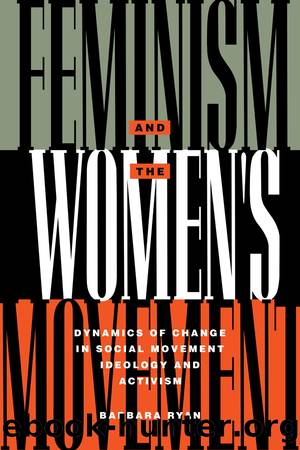Feminism and the Women's Movement: Dynamics of Change in Social Movement Ideology and Activism by Barbara Ryan

Author:Barbara Ryan [Ryan, Barbara]
Language: eng
Format: epub
Tags: History, General, Social Science, Sociology
ISBN: 9781317796107
Google: soZEAgAAQBAJ
Goodreads: 670200
Publisher: Routledge
Published: 1992-08-20T00:00:00+00:00
Indeed, what was happening throughout the 1970s and 1980s was that child care bills promoted by feminist and social activists became increasingly difficult to get out of congressional hearings. In 1988 the Act for Better Child Care Services (ABC) and Parental Leave Act made it to the House floor, but were tabled in order to do what Senator Robert Dole called âbusiness that is importantâ (cited in Simpson 1988: 82). In opposition to feminist efforts, the United States continues to be the only industrialized country (with the exception of South Africa) with no federal program for maternal leave or a child care system.
In the second example, an article published in the Harvard Business Review (Schwartz 1989) claimed mothers are a corporate liability because they cost business money with maternity leave and sick pay; thus, investing in expensive training means an economic loss to companies. The author, Felice Schwartz,2 argues for a new lower-pressure career track for those women who place their family obligations in high priority. Citing the need to develop employment policies that help mothers balance their obligations, she suggests women would fall into either a career-primary track or a career-and-family track (dubbed the âmommy trackâ by the popular press). Feminists responded that the article was full of sexist, racist, and classist assumptions, such as the assumption that employment for all mothers is optional. Moreover, they argued that Schwartz was carelessly conflating the biological role of maternity, which is done by women, with the social role of child rearing, which can be done by either sex.
What Schwartz did in her article was to present a sexist solution to a very real problem of womenâs work/family role conflicts. Rather than address the need for dual parenting responsibilities, non-penalized flexible work schedules and social service provision, she suggests a formula for keeping women in a secondary position in the workforce. Barbara Enrenreich and Deidre English consider the publicity generated by this article to be an indication of a negative reception to women in careers in general.
It should never have been taken seriously, not by the media and not by the nationâs most prestigious academic business publication. The fact that it was suggests that something serious is afoot: a backlash against Americaâs high-status, better paid women, and potentially against all women workers. (Ehrenreich and English 1989: 58; emphasis in the original)
Download
This site does not store any files on its server. We only index and link to content provided by other sites. Please contact the content providers to delete copyright contents if any and email us, we'll remove relevant links or contents immediately.
On the Front Line with the Women Who Fight Back by Stacey Dooley(4697)
The Lonely City by Olivia Laing(4571)
The Rules Do Not Apply by Ariel Levy(4525)
Bluets by Maggie Nelson(4263)
The Confidence Code by Katty Kay(4040)
Three Women by Lisa Taddeo(3281)
Inferior by Angela Saini(3152)
Not a Diet Book by James Smith(3151)
A Woman Makes a Plan by Maye Musk(3145)
Confessions of a Video Vixen by Karrine Steffans(3101)
Pledged by Alexandra Robbins(3049)
Wild Words from Wild Women by Stephens Autumn(2939)
Nice Girls Don't Get the Corner Office by Lois P. Frankel(2934)
Brave by Rose McGowan(2738)
Women & Power by Mary Beard(2618)
The Girl in the Spider's Web: A Lisbeth Salander novel, continuing Stieg Larsson's Millennium Series by Lagercrantz David(2614)
Why I Am Not a Feminist by Jessa Crispin(2585)
The Clitoral Truth: The Secret World at Your Fingertips by Rebecca Chalker(2585)
Women on Top by Nancy Friday(2449)
